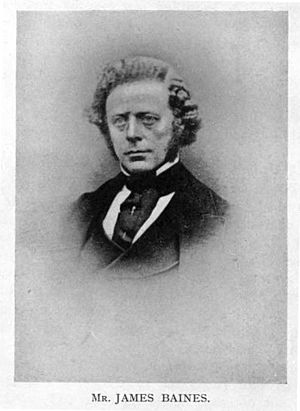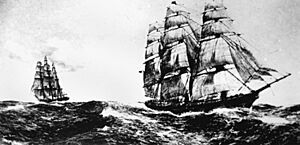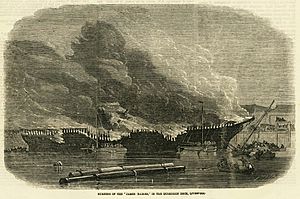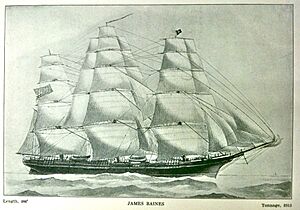James Baines (clipper) facts for kids
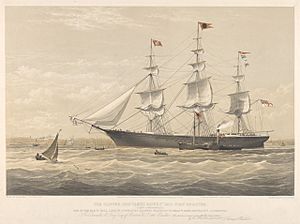
James Baines
|
|
Quick facts for kids History |
|
|---|---|
| Namesake | James Baines, ship owner |
| Owner | James Baines & Co. |
| Ordered | 1853 |
| Builder | Donald McKay, East Boston |
| Laid down | 1854 |
| Launched | 25 July 1854 |
| Christened | 25 July 1854 by James Baines |
| Commissioned | 12 September 1854 |
| Out of service | 22 April 1858 |
| Homeport | Liverpool |
| Fate | |
| General characteristics | |
| Class and type |
|
| Tonnage | 2,275 GRT |
| Displacement | 2,515 tons (2,555 tonnes) at 29 ft (8.8 m) draught (1.000 tons ship mass + 1.455 tons cargo & passengers' mass) |
| Length |
|
| Beam | 44 ft (13 m) |
| Draught | 29 ft (8.8 m) loaded |
| Propulsion | Sails |
| Speed | 21 kn (39 km/h) on 17 June 1856 at 44°S, 106°E; best 24-hour run: 342 nmi (633 km) in 1854 |
| Boats & landing craft carried |
6 lifeboats |
| Capacity | 1,400 tons cargo + 700 passengers |
| Complement | 100 crew |
The James Baines was a very fast clipper ship built entirely from timber in the 1850s. It was launched on July 25, 1854. The ship was built by the famous Donald McKay in East Boston, USA. It was made for the Black Ball Line of James Baines & Co. in Liverpool, England. This clipper was one of the few large sailing ships to have a special sail called a moonsail.
Contents
Ship Design and Features
The ship builder Donald McKay used all his skills to create James Baines. He even fixed small issues found in his previous ships. James Baines was designed to be very strong and beautiful. Its main frame was made of white oak, and other parts like the decks were made of hard pine.
The ship's hull was strengthened with iron and built very carefully. Experts at the time said its design was unmatched by any other ship McKay had built. The front (bow) and back (stern) of the ship had beautiful gold carvings. The hull was painted black with blue stripes.
Luxury and Comfort Onboard
James Baines was built for passengers, so it had very fancy rooms. First-class areas had the best furniture and mahogany wood panels. There were also standard rooms for up to 700 passengers. The ship had fancy dining rooms and private cabins.
It had three main decks, a poop deck at the back, and two deck houses. These areas provided space for passengers and the 100 crew members. The ladies' cabin and the captain's rooms were at the back of the ship. All rooms had good air flow and plenty of light. James Baines was known for being both beautiful and incredibly fast. It still holds sailing records today.
The ship was named after its owner, James Baines. He owned the famous Black Ball Line. One ship owner in Liverpool called it "the most perfect ship afloat." When it first arrived in Liverpool, people praised it greatly. They said it was the most perfect sailing ship ever to enter the River Mersey. The ship's figurehead (a carving at the front) was a perfect likeness of James Baines himself.
A Record-Breaking History
Captain Charles McDonnell, who used to command the ship Marco Polo, became the master of James Baines. Its first trip from Boston to Liverpool was incredibly fast. It took only 12 days and six hours, from September 12 to 24, 1854. This is still an unbroken sailing ship record!
The ship also made very fast trips to Australia. Its first journey from Liverpool to Melbourne took only 65 days in 1854. The return trip took 69 and a half days. During that return trip, it made a famous run of 420 nautical miles (780 km) in one day.
James Baines completed four round trips between Melbourne and Liverpool. In July 1857, Queen Victoria and Prince Albert visited the ship in Portsmouth. The Queen was very impressed, saying she didn't know such a splendid ship existed in her country's merchant fleet. The ship was in Portsmouth to carry 1,000 soldiers of the 97th Regiment to India. It later returned to England with a cargo of goods like jute and rice.
Fire and the Ship's End
On April 22, 1858, James Baines caught fire. This happened while it was unloading cargo in the Huskisson Dock in Liverpool. The fire destroyed the ship down to the waterline.
The remains of the ship and most of its cargo were a complete loss. This cost its owner, James Baines, about £170,000. Sadly, the ship's insurance had run out just three days before the fire.
The damaged hull was sold for £1,080. It was then turned into a coal barge. Some say it crashed with another barge in 1860 in Galway harbour, Ireland. The ship was still listed in the Liverpool Ship's Register in 1863, but its final fate is unknown. Another story says it became a floating platform in Liverpool harbour for passengers getting off steamships.
Captain Charles McDonnell, who was the first and last captain of James Baines, was heartbroken. He stopped working at sea and passed away a few months later.
How the Ship Sailed
James Baines was a very large ship, weighing 2,275 tons. It could carry 1,400 tons of cargo. It also had room for 800 passengers and crew across its five decks.
As a full-rigged ship, it had three masts: the fore, main, and mizzen masts. These masts could carry a maximum of 43 sails! This included:
- 16 square sails (large rectangular sails)
- 6 staysails (triangular sails between masts)
- 4 jibs (sails at the front of the ship)
- 1 fore and aft sail called a spanker
- 16 studding sails (extra sails used in light winds)
Each mast had several sails, including a course sail, a topsail, a topgallant sail, a royal sail, and a skysail. The main-skysail mast was later made longer to fit a special moonsail.


